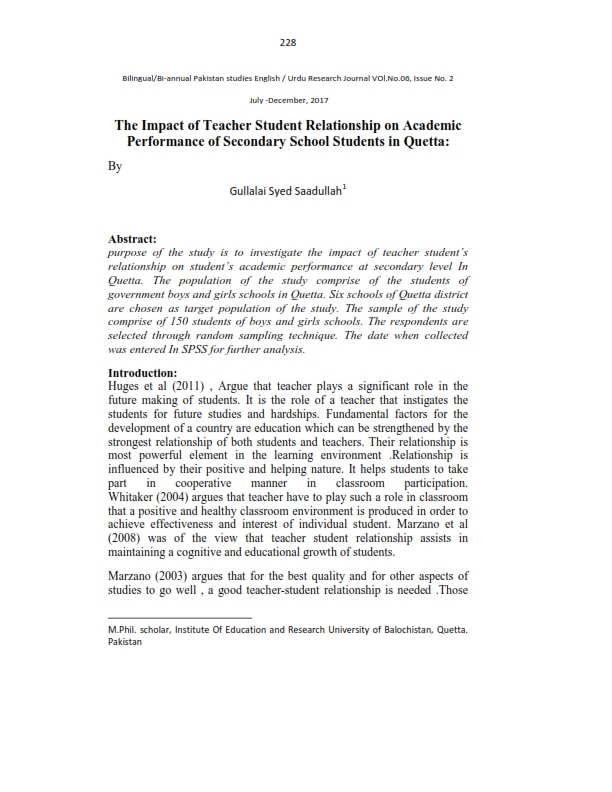The Impact of Teacher Student Relationship on Academic Performance of Secondary School Students in Quetta
Keywords:
teacher student’s relationship, academic performance, government boys and girls schoolsAbstract
purpose of the study is to investigate the impact of teacher student’s
relationship on student’s academic performance at secondary level In
Quetta. The population of the study comprise of the students of
government boys and girls schools in Quetta. Six schools of Quetta district
are chosen as target population of the study. The sample of the study
comprise of 150 students of boys and girls schools. The respondents are
selected through random sampling technique. The date when collected
was entered In SPSS for further analysis.
References
Alberto, P. A. & Troutman, (2003). Applied behavior analysis for
teachers. (6th ed.). Upper Saddle River, New Jersey: Merrill, Prentice Hall.
(Original work published 1982)
Anderman, L. H., & Kaplan, A. (2008). The role of interpersonal
relationships in student motivation: Introduction to the special issue.
Journal of Experimental Education, 76(2), 115-119.
Boss, C. S., & Vaughn, S. (2002). Strategies for Teaching Students with
Learning and Behavior Problems (5th ed.). Boston: Allyn and Bacon.
(Original work published 1988).
Carter, S.C. (2000). No Excuses: Lessons from 21 High-Performing,
High-Poverty Schools. Washington, D.C., The Heritage Foundation.
Cohen, J. (1992). Statistical power analysis for the behavioral sciences
(2nd ed.). Mahwah, NJ: Lawrence Erlbaum Associates.
Marzano, R. J., & Marzano, J. S. (2008).“Dimensions of Learning”
Michigan Department of Education. Tending to the Spirit/Culture.
Retrieved January 11, 2009, from http://www.michigan.gov/documents/3-
_107241_7.pdf.
Miller, W. R., & Rose, H. C. (1975). Instructors and their jobs.
Homewood, Illinois: American Technical Publishers, Inc. (Original work
published 1961).
National Center for Educational Statistics: Digest of Education Statistics.
Retrieved October 7, 2007, from National Center for Educational
Statistics: http://nces.ed.gov/programs/digest/d07/tables/dt07_089.asp
Patrick, H., Mantzicopoulos, P., Samarapungavan, A., & French, B. F.
(2008). Patterns of Young Children's Motivation for Science and TeacherChild Relationships. Journal of Experimental Education, 76(2), 121-144.
Pawlas, G. E. (2005). Administrator's Guide to School-Community
Relations (Second ed.) NY: Eye on Education.
Stewart, E. B (2008). Individual and School Structural Effects on African
American High School Students' Academic Achievement. The High
School Journal 91.2 (2007) 16-34.
Walker Tileston, D. (2004). What every teacher should know about
student motivation. California: Corwin Press.
Whitaker, Todd. (2004). What Great Principals Do Differently.
Larchmont, NY: Eye On Education, Inc.



